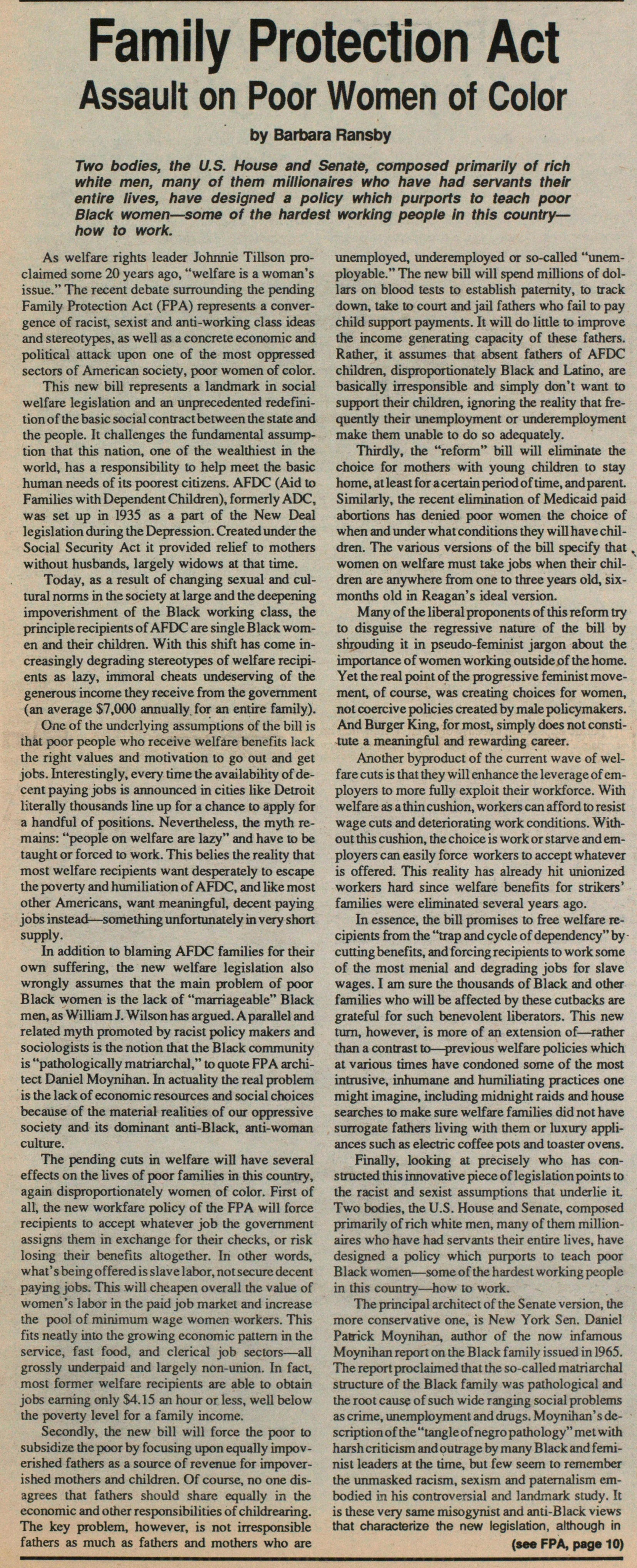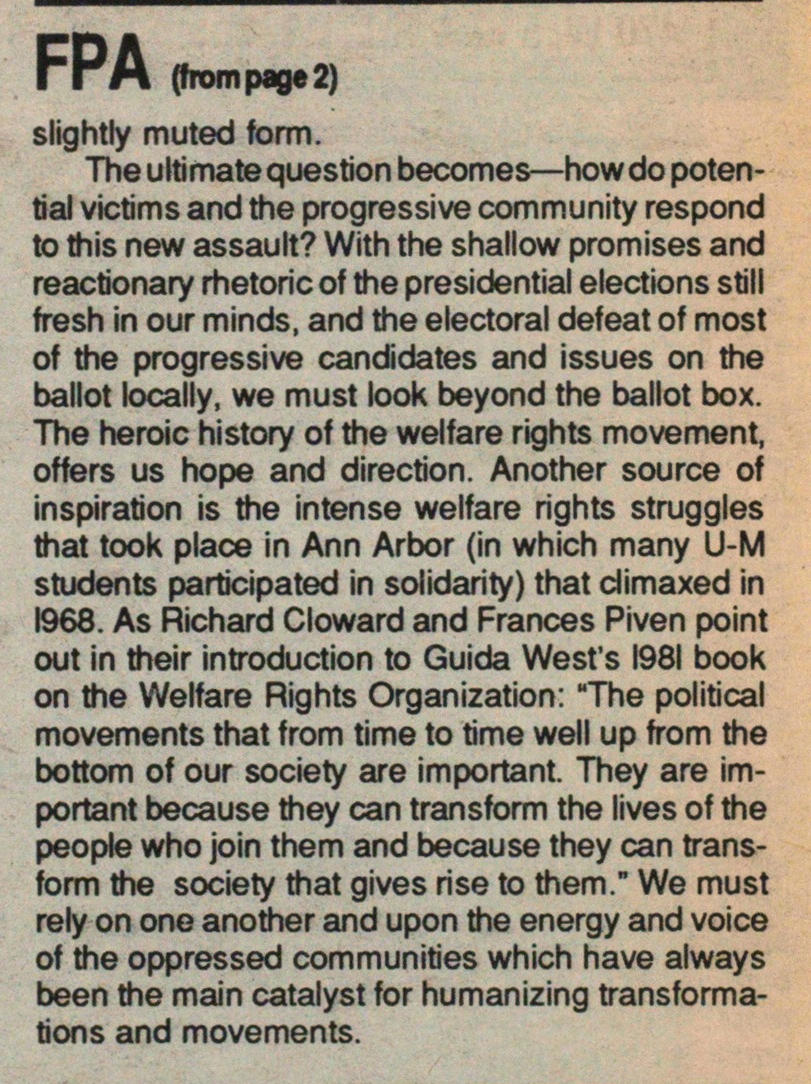Family Protection Act Assault On Poor Women Of Color


Family Protection Act
Assault on Poor Women of Color
by Barbara Ransby
Two bodies, the U.S. House and Senate, composed primarily of rich white men, many of them millionaires who have had servants their entire lives, have designed a policy which purports to teach poor Black women-some of the hardest working people in this country- how to work.
As welfare rights leader Johnnie Tillson proclaimed some 20 years ago, "welfare is a woman's issue." The recent debate surrounding the pending Family Protection Act (FPA) represents a convergence of racist, sexist and anti-working class ideas and stereotypes, as well as a concrete economic and political attack upon one of the most oppressed sectors of American society, poor women of color.
This new bill represents a landmark in social welfare legislation and an unprecedented redefinition of the basic social contract between the state and the people. It challenges the fundamental assumption that this nation, one of the wealthiest in the world, has a responsibility to help meet the basic human needs of its poorest citizens. AFDC (Aid to Families with Dependent Children), formerly ADC, was set up in 1935 as a part of the New Deal legislation during the Depression. Created under the Social Security Act it provided relief to mothers without husbands, largely widows at that time.
Today, as a result of changing sexual and cultural norms in the society at large and the deepening impoverishment of the Black working class, the principle recipients of AFDC are single Black women and their children. With this shift has come increasingly degrading stereotypes of welfare recipients as lazy, immoral cheats undeserving of the generous income they receive from the government (an average $7,000 annually, for an entire family).
One of the underlying assumptions of the bill is that poor people who receive welfare benefits lack the right values and motivation to go out and get jobs. Interestingly, every time the availability of decent paying jobs is announced in cities like Detroit literally thousands line up for a chance to apply for a handful of positions. Nevertheless, the myth remains: "people on welfare are lazy" and have to be taught or forced to work. This belies the reality that most welfare recipients want desperately to escape the poverty and humiliation of AFDC, and like most other Americans, want meaningful, decent paying jobs ins tead - something unfortunately in very short supply.
In addition to Wam ing AFDC families for their own suffering, the new welfare legislation also wrongly assumes that the main problem of poor Black women is the lack of "marriageable" Black men, as William J. Wilson has argued. A parallel and related myth promoted by racist policy makers and sociologists is the notion that the Black community is "pathologically matriarchal," to quote FPA architect Daniel Moynihan. In actuality the real problem is the lack of economie resources and social choices because of the material realities of our oppressive society and its dominant anti-Black, anti-woman culture.
The pending cuts in welfare will have several effects on the lives of poor families in this country, again disproportionately women of color. First of all, the new workfare policy of the FPA will force recipients to accept whatever job the government assigns them in exchange for their checks, or risk losing their benefits altogether. In other words, what' s being of fered is slave labor, not secure decent paying jobs. This will cheapen overall the value of women's labor in the paid job market and increase the pool of minimum wage women workers. This fits neatly into the growing economic pattern in the service, fast food, and clerical job sectors - all grossly underpaid and largely non-union. In fact, most former welfare recipients are able to obtain jobs eaming only $4.15 an hour or less, well below the poverty level for a family income.
Secondly, the new bill will force the poor to subsidize the poor by focusing upon equally impoverished fathers as a source of revenue for impoverished mothers and children. Of course, no one disagrees that fathers should share equally in the economic and other responsibilities of childrearing. The key problem, however, is not irresponsible fathers as much as fathers and mothers who are unemployed, underemployed or so-called "unemployable." The new bill will spend millions of dollars on blood tests to establish paternity, to track down, take to court and jail fathers who fail to pay child support payments. It will do little to improve the income generating capacity of these fathers. Rather, it assumes that absent fathers of AFDC children, disproportionately Black and Latino, are basically irresponsible and simply don't want to support their children, ignoring the reality that frequently their unemployment or underemployment make them unable to do so adequately.
Thirdly, the "reform" bill will eliminate the choice for mothers with young children to stay home, at least for a certain period of time, and parent Similarly, the recent elimination of Medicaid paid abortions has denied poor women the choice of when and under what conditions they will have children. The various versions of the bill specify that . women on welfare must take jobs when their children are anywhere from one to three years old, sixmonths old in Reagan's ideal version.
Many of the liberal proponents of this reform try to disguise the regressive nature of the bill by shrouding it in pseudo-feminist jargon about the importance of women working outside of the home. Yet the real point of the progressive feminist movement, of course, was creating choices for women, not coercive policies created by male policy makers . And Burger King, for most, simply does not constitute a meaningful and rewarding career.
Another byproduct of the current wave of welfare cuts is that they will enhance the leverage of employers to more fully exploit their workforce. With welfare as a thin cushion, workers can afford to resist wage cuts and deteriorating work conditions. Without this cushion, the choice is work or starve and employers can easily force workers to accept whatever is offered. This reality has already hit unionized workers hard since welfare benefits for strikers' families were elimina ted several years ago.
In essence, the bill promises to free welfare recipients from the "trap and cycle of dependency " by cutting benefits, and forcing recipients to work some of the most menial and degrading jobs for slave wages. I am sure the thousands of Black and other families who will be affected by these cutbacks are grateful for such benevolent liberators. This new turn, however, is more of an extension of - rather than a contrast to - previous welfare policies which at various times have condoned some of the most intrusive, inhumane and humiliating practices one might imagine, including midnight raids and house searches to make sure welfare families did not have surrogate fathers living with them or luxury appliances such as electric coffee pots and toaster ovens.
Finally, looking at precisely who has constructed this innovative piece of legislation points to the racist and sexist assumptions that underlie it Two bodies, the U.S. House and Senate, composed primarily of rich white men, many of them millionaires who have had servants their entire lives, have designed a policy which purports to teach poor Black women - some of the hardest working people in this country - how to work.
The principal architect of the Senate version, the more conservative one, is New York Sen. Daniel Patrick Moynihan, author of the now infamous Moynihan report on the Black family issued in 1965. The report proclaimed that the so-called matri arenal structure of the Black family was pathological and the root cause of such wide ranging social problems as crime, unemployment and drugs. Moynihan' s description of the "tangle of negro pathology" met with harsh criticism and outrage by many Black and feminist leaders at the time, but few seem to remember the unmasked racism, sexism and patemalism embodied in his controversial and landmark study. It is these very same misogynist and anti-Black views that characterize the new legislation, although in
(see FPA, page 10)
FPA (from page 2)
slightly muted form.
The ultímate question become s - how do potential victims and the progressive community respond to this new assault? With the shallow promises and reactionary rthetoric of the presidential elections still fresh in our minds, and the electoral defeat of most of the progressive candidates and issues on the ballot locally, we must look beyond the ballot box. The heroic history of the welfare rights movement, offers us hope and direction. Another source of nspiration is the intense welfare rights struggles that took place in Ann Arbor (in which many U-M students participated in solidarity) that climaxed in 1968. As Richard Cloward and Frances Piven point out in their introduction to Guida West's 1981 book on the Welfare Rights Organization: "The political movements that from time to time well up trom the bottom of our society are important. They are important because they can transform the lives of the people who join them and because they can transform the society that gives rise to them." We must rely on one another and upon the energy and voice of the oppressed communities which have always been the main catalyst for humanizing transformations and movements.